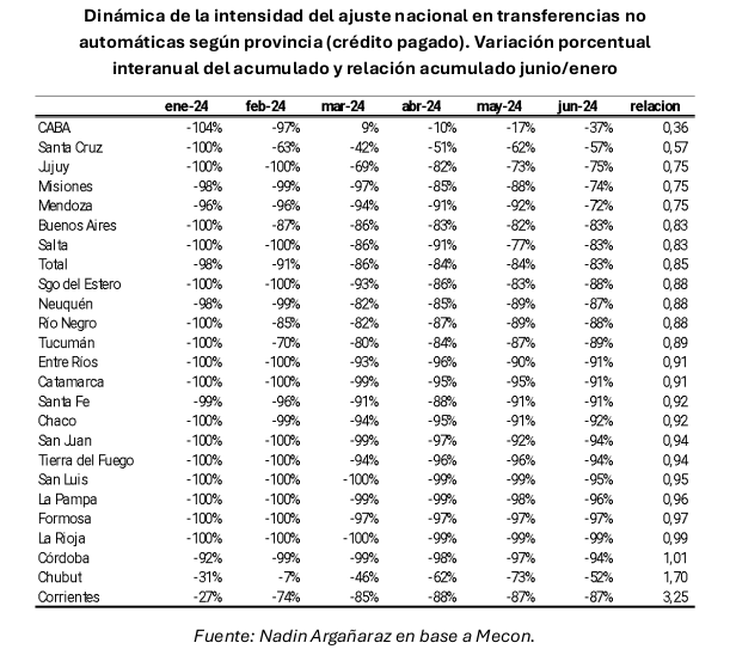Although it may seem contradictory, in the Government’s eagerness to achieve a fiscal surplus this year, one of the biggest adjustments is being applied to the provinces, although in real terms The intensity of the same at the end of the first semester is less than at the beginning of the year.
This is only from the point of view of the funds actually paid. If we look instead at accrued expenditure, that is, the expenditure generated but not paid, the adjustment is tougher now than in January.
This is highlighted in a report by the director of the Argentine Institute of Fiscal Analysis (IARAF), Nadin Argañaraz.
From the point of view of the expenditure generated, but not yet paid, the analysis shows that, In 22 jurisdictions, the national government increased the intensity of the cuts in funds accrued throughout the first half of the year.
“Only to two jurisdictions, the City of Buenos Aires and Santa Cruz, had their numbers reduced. The most benefited is CABA, a jurisdiction that at the beginning of the year had a real interannual cut of 77%, and at the end of the semester one of 42%,” Argañaraz points out in a report.
accrued-prov.expense.png
The second Santa Cruz benefited, going from a year-on-year reduction of 54% to 53.5%.
At the other extreme, the province to which the intensity of the accrued adjustment increased the most in Corrientes. From a 15% year-on-year reduction in January, it fell to 86% in the first half of the year. Tierra del Fuego and La Pampato complete the list of provinces that saw the intensity of the adjustment increase the most over the months.
“What is clearly seen is that The national government was increasing the intensity of the adjustment with the provinces over the months,” the report indicates when speaking of the accrual.
The report says that “the year-on-year reduction of The accrued transfers started at 62% and then gradually increased until reaching 79% at the end of the first semester.” But when it comes to the funds that were paid the situation is reversed.
expense-prov-paid.png

Chainsaw over provinces: which are the most and least benefited
“Unlike what happened With the accrual, in this case it appears that the national government reduced the intensity of the effective cut in 20 jurisdictions funds throughout the first half of the year,” the study says. In other words, it sent them more money.
Only two jurisdictions saw the intensity of funding cuts increased: Corrientes and Chubut, that is, they received less funds.
The most negative is Corrientes, a jurisdiction that at the beginning of the year collected 73% of the funds it was entitled to, only received 13% at the end of the semester. The second is Chubut, which went from receiving 69% to collecting 48% of what it is entitled to.
In the other, the province that benefited the most was lthe city of Buenos Aires, which started receiving zero pesos and closed the semester collecting 63% of the corresponding funds.
Santa Cruz and Jujuy follow, completing the list of provinces whose situation has improved the most over the months.
“What is clearly seen is that the national government, unlike what it was doing with the accrual of funds,“We are reducing the intensity of the adjustment with the specific sending of funds to the provinces over the months,” says Argañaraz.
The analyst states that “the year-on-year reduction in transfers paid toIt started at 98% and then gradually decreased until it reached 83% at the end of the first semester,” the report says.
Source: Ambito




